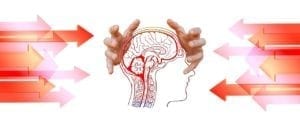In a new article in the journal Science Advances, neuroscientists have found a specific mechanism that is responsible for the familial migraines. A type of brain cell called astrocytes have been found to malfunction in the region of the brain that activates pain.
Their failure to clear out the buildup of transmitters released by the neurons makes the pain region more sensitive, and more likely to be activated by pain triggers related to the head.
Familial Hemiplegic Migraines
Familial hemiplegic migraines are a type of serious inherited migraine condition which consists of intense headaches. They are often accompanied by other symptoms such as nausea, light and sound sensitivity, and throbbing, often in only one region of the head. The headaches tend to be very intense and caused by certain triggers such as specific foods, changes in routine, or stress. Findings suggest they are largely affecting the central nervous system, in which their cortical response, part of the brain stem, is more stimulated by what they are sensing.
The Mechanism Triggering The Pain
The new research have reportedly discovered the mechanism by which the mutation triggers the disorder: an issue in the part of the brain where pain signaling occurs, the cingulate cortex. The astrocytes, star-shaped brain cells, are unable to preform their normal role in maintaining neural functioning by clearing neuron transmitters. This makes the neurons fire more quickly, activating that area of the brain with intensity.
They also found that this mechanism made migraines more frequent.
Lab Online reported that the head of the study, Mirko Santello, said, “Despite their abundance, astrocytes have been relatively overlooked by neuroscientists.” In mice models, they found that the mice with the issues with their cingulate cortex were more sensitive to headaches and had them at higher frequencies.
Discoveries Lead to Fixes
This led to something even more exciting for migraine sufferers- ideas for how to fix it.
“By manipulating astrocytes in the cingulate cortex, we were able to reverse their dysfunction. This prevented an increase in head pain in mice carrying the genetic defect.” – Jennifer Ramanos, first study author
This study proved how the malfunction caused by this genetic mutation directly corresponds to increased likelihood and sensitivity to headaches.
The new findings could lead to a better understanding of how to treat the painful disease. Their results suggest the cingulate cortex may be key to the disorder mechanism and thus the key in treating it.







